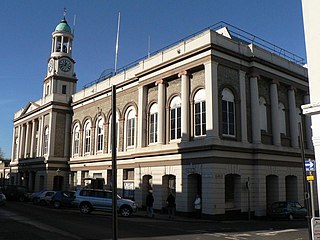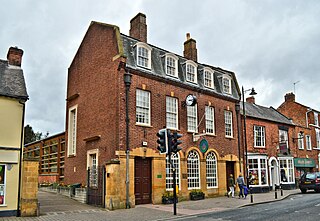
Sandown is a seaside resort town and civil parish on the south-east coast of the Isle of Wight, England. The resort of Shanklin and the settlement of Lake are sited just to the south of the town. Sandown has a population of 11,654, according to the 2021 Census; together with Shanklin and Lake, it forms a built-up area of around 25,000 inhabitants. It is the northernmost town of Sandown Bay, with an easily accessible, sandy shoreline with beaches that run continuously from the cliffs at Battery Gardens in the south to Yaverland in the north.

Ventnor is a seaside resort town and civil parish established in the Victorian era on the southeast coast of the Isle of Wight, England, eleven miles (18 km) from Newport. It is situated south of St Boniface Down, and built on steep slopes leading down to the sea. The higher part is referred to as Upper Ventnor ; the lower part, where most amenities are located, is known as Ventnor. Ventnor is sometimes taken to include the nearby and older settlements of St Lawrence and Bonchurch, which are covered by its town council. The population is 5,567 according to the 2021 Census

Shanklin is a seaside resort town and civil parish on the Isle of Wight, England, located on Sandown Bay. Shanklin is the southernmost of three settlements which occupy the bay, and is close to Lake and Sandown. The sandy beach, its Old Village and a wooded ravine, Shanklin Chine, are its main attractions. The esplanade along the beach is occupied by hotels and restaurants for the most part, and is one of the most tourist-oriented parts of the town. The other is the Old Village, at the top of Shanklin Chine. Together with Lake and Sandown to the north, Shanklin forms a built up area of around 25,000 inhabitants, Shanklin alone contributing around 7,200 of this.

Sandown Bay is a broad open bay which stretches for much of the length of the Isle of Wight's southeastern coast. It extends 8+1⁄2 miles (13.7 km) from Culver Down, near Yaverland in the northeast of the Island, to just south of Shanklin, near the village of Luccombe in the southwest. At Luccombe, the bay is separated from The Undercliff by a large headland from which Upper Ventnor sits atop. The towns of Shanklin, Lake and Sandown are on the bay's coast, while Luccombe and Upper Ventnor feature panoramic views across both Sandown Bay to the East and the Undercliff to the southwest. Due to the bay being relatively sheltered from offshore winds it is often used as temporary anchorage point for boats, including large cargo ships, before continuing east towards Continental Europe, or north towards The Solent.

Lake is a large village and civil parish located on Sandown Bay, on the Isle of Wight, England. It is six miles south-east of Newport situated between Sandown and Shanklin, and 1+1⁄2 miles (2.4 km) to the east of the hamlet of Apse Heath.

Yaverland is a village and former civil parish, now in the parish of Sandown, on the Isle of Wight, England. It is just north of Sandown on Sandown Bay. It has about 200 houses. About 1⁄3 of a mile away from the village is the Yaverland Manor and Church. Holotype fossils have been discovered here of Yaverlandia and a pterosaur, Caulkicephalus. The White Air extreme sports festival was held annually at Yaverland pay and display car park between 1997 and 2008, but moved to Brighton for 2009.

Mullingar Arts Centre, is a municipal building in Mount Street, Mullingar, County Westmeath, Ireland. Formerly known as County Hall, it was the meeting place of both Westmeath County Council and Mullingar Town Council.

Ryde Town Hall is a municipal structure in Lind Street in Ryde, Isle of Wight, England. The town hall, which was the headquarters of Ryde Borough Council, is a Grade II listed building.

East Cowes Town Hall is a municipal building in York Avenue, East Cowes, Isle of Wight, England. The structure, which is the meeting place of East Cowes Town Council, is a locally listed building.

Sandown Town Hall is a municipal building in Grafton Street, Sandown, Isle of Wight, England. The structure, which was the meeting place of Sandown Urban District Council, is a Grade II listed building.

Horbury Town Hall is a former municipal building in Westfield Road, Horbury, West Yorkshire, England. The structure, which is now used as business centre, is a locally listed building.

Whitchurch Town Hall is a municipal structure in Newbury Street, Whitchurch, Hampshire, England. The structure, which is the meeting place of Whitchurch Town Council, is a Grade II listed building.

The Old Town Hall is a former events venue in Prince of Wales Road, Cromer, Norfolk, England. The structure, which is currently used for retail purposes, is a grade II listed building.

New Cumnock Town Hall is a municipal building in Castle, New Cumnock, East Ayrshire, Scotland. The structure, which is used as a community events venue, is a Category C listed building.

Prescot Town Hall is a municipal building in Warrington Road, Prescot, a town in Merseyside, England. The building is currently used as the offices and meeting place of Prescot Town Council.

Pershore Town Hall is a municipal building in the High Street in Pershore, a town in Worcestershire, in England. Originally commissioned as a post office, it is now the headquarters of Pershore Town Council.

Kington Town Hall is a former municipal building in the High Street in Kington, a town in Herefordshire in England. In the 1970s, the building was split into three units, with shops on the ground floor of two of the units, and the remainder of the complex converted for residential use. All three of the units are Grade II listed buildings.
The Old Town Hall Chambers is a historic building in the High Street in Newport Pagnell, a town in Buckinghamshire, in England. The building, which served as a public events venue, is a grade II listed building.

Ventnor Town Hall is a historic building in Albert Street in Ventnor, a town on the Isle of Wight, in England. The facade of the building, behind which new flats have been created, is a Grade II listed building.

The Isles of Scilly Town Hall is a municipal building in Hugh Town, on the Isles of Scilly, in England. The building, which serves as the offices of Council of the Isles of Scilly, is a Grade II listed building.




















